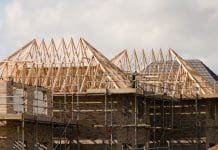Digitisation has freed modular from outdated preconceptions of prefabricated construction and offers an opportunity to deliver attractive, good quality housebuilding that meets design codes, regulations and environmental regulations, says Chris Hartiss RIBA, design director at Modulous
For many architects, the very concept of modular housing feels about as far away from great design as you can get.
Homes designed, manufactured and assembled offsite have historically been “blocky’, “soulless” and less loved than their traditionally built counterparts. Often characterised by a limited materials palette and standardised parameters, MMC technology has sometimes led to much-maligned uniformity in modular housing. It’s a stereotype borne out of the widespread use of prefabrication in post-war Britain, when mass manufactured “temporary” housing promised to be an efficient, cheap and practical solution to rampant undersupply.
The scale of the crisis justified an immediate response and the government delivered. In the face of such overwhelming social pressures, few were minded to fight for design quality.
The unloved status of modular housing has hardly been helped by the influence of 20th century dystopian fiction. To some, the idea of an entirely modular built environment brings to mind a cityscape filled with identical grey boxes stacked one on another, their scale dwarfing the individuals that inhabit them.
No longer a “one-size-fits-all” solution
In truth, modular housing has long departed from the past and the misconceptions that come with it. Offsite manufacturing is now fundamentally different from prefab because modular housing is no longer restricted by “one-size-fits-all” design and the customisation of modular solutions introduces a breadth of typologies that are informed, defined and ultimately led by architectural ambition.
Modulous has taken this further and is enabling architects, developers, operators and others to deliver high quality housing, using a physical kit of parts built upon a decentralised “digital thread” of global supply chain partners. Leveraging the existing network of large manufacturers to produce the Kit of Parts rather than building dedicated factories unlocks scalability and digitising the kit of parts enables generative design software to rapidly iterate comparable solutions, the latter freeing up architects to focus on the value-added aspects of their creative input.
An age of high-performance engineering
Now more than ever, digitisation is accelerating, rather than reducing, the scope for architectural flexibility. Designs can be gloriously diverse – there’s no house style, no impersonal, alienating uniformity. We’ve shifted into an age of high-performance engineering, where modular housing is not limited in its mix and materials by the drive to achieve cost efficiencies. We can have our cake and eat it, too, democratising good quality homebuilding where modular is a tool to deliver to local design codes and ever-more stringent environmental regulations.
Software platforms can harvest big data to generate legislatively compliant, costed and technically feasible solutions that can form the basis of a scheme design while guaranteeing buildability and delivering cost and programme certainty from the outset.
So, what does this translate to? With less time spent on the feasibility and massing option studies, it means more time can be devoted to ensuring buildings are suited to not only today’s social, commercial and contextual challenges but also to a fast-transitioning, low-carbon economy.
As an architect, I’m truly excited by the potential of software-enabled modular design to transform the way that we engage with our craft. Thirty years ago, architects feared that the computer-aided design (CAD) would draw all the joy from the design process and result in a dowdy and uniform built environment. CAD has now largely been replaced with BIM but architects are still designing and delivering brilliant architecture as creatively as ever. The technological revolution the construction industry now faces is an opportunity to do it even more creatively.
Chris Hartiss RIBA 
Design director
Modulous
Tel: +44 (0)203 582 1005
Twitter: @ModulousLimited
LinkedIn: Modulous














